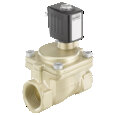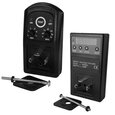A Guide to Shower Timer Control Valves
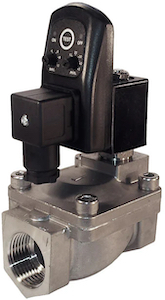
Figure 1: A stainless steel 2/2 solenoid valve with a mounted timer.
A solenoid valve is particularly suitable as a shower timer control valve due to its precise operation and ability to regulate water flow quickly and efficiently. In modern bathrooms and automated systems, controlling water usage and temperature is not just a luxury but a necessity to save water and enhance convenience. This article is an overview of the workings of solenoid valves, shower control systems, and the settings where these systems are commonly used.
Table of contents
- Shower control systems
- Selecting a solenoid valve for shower control
- Shower timer control valve applications
- FAQs
View our online selection of solenoid valves and timers!
Shower control systems
Shower control systems are designed to allow users to manage water flow and temperature according to their preferences. Advanced shower systems incorporate valve timers, which are instrumental in conserving water by allowing the flow to be controlled and automatically stopped after a set duration. This feature is particularly beneficial in public facilities, such as gyms or campgrounds, where managing water usage is crucial.
The core components of a shower control system with a valve timer include:
- Control panel or interface: This is where the user interacts with the system, setting the desired temperature and shower duration.
- Thermostatic mixing valve: This valve blends hot and cold water to reach the user's chosen temperature, maintaining it consistently throughout the shower.
- Solenoid valve: Positioned in the water line, this electrically-actuated valve controls the start and stop of water flow based on signals from the valve timer.
- Valve timer: This electronic or mechanical device is programmed to allow water flow for a specific period before signaling the solenoid valve to shut off.
In a typical timed shower control system, the solenoid valve is used in combination with a digital timer to control the duration of hot water supply. The timer is mounted directly on the valve and can be set with a few buttons (Figure 2). The timer can be programmed to remain on for a few minutes and then switch off until the timer is reset. A typical design includes a light switch to control the timer (Figure 3):
- The light switch is turned on, opening the solenoid valve and supplying warm water for the timer's set time.
- When the set time finishes, the solenoid valve closes, which stops the supply of warm water.
- To reset the timer, the light switch must be switched off and then on again.
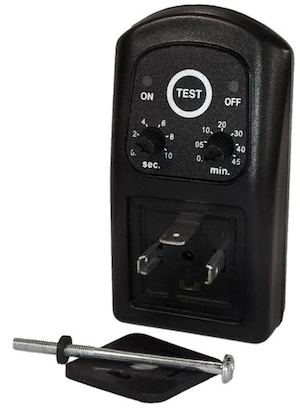
Figure 2: Analog timer's front panel: LED status in the ON position (A), ON time (B), LED status in the OFF position (C), TEST button (D), and OFF time (E).
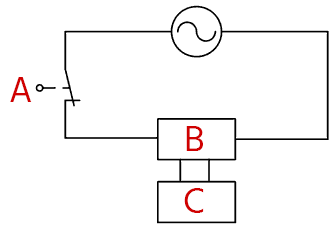
Figure 3: Diagram for a timer in a camping shower: light switch (A), timer (B), solenoid valve (C).
Some shower control systems with valve timers also include additional features such as:
- Flow rate control: To further manage water usage, the system can regulate the flow rate, providing an efficient shower experience while minimizing waste.
- User memory functions: For personalized settings, some systems can remember preferred shower duration and temperatures for different users.
- Safety lockouts: To prevent tampering or excessive water use, systems can be equipped with lockout functions that limit how often the shower can be operated within a certain time frame.
Selecting a solenoid valve for shower control
The solenoid valve must be compatible with the system's requirements and water. Typically, a solenoid valve for a shower timer system has the following criteria:
- Direct-acting solenoid valve: A direct-acting solenoid valve is typical for this system because it operates independently of pressure differential and has a fast response time with low power consumption.
- Valve size: An average shower system has a flow rate of 9.5 lpm (2.5 gpm) and pressure between 0.1 and 3 bar. A valve's flow rate can be defined by its Kv or Cv value.
- Body material: Common body materials are brass, stainless steel, and plastic. Brass is a good choice for durability and cost-effectiveness.
- Voltage and power requirements: Solenoid valves can run on DC or AC. Choose a valve that matches the power supply both in current type and voltage.
- Pressure rating: Ensure the valve can handle the water supply's pressure rating. For residential systems, a typical water pressure is between 3.1 and 5.5 bar (45 - 80 psi).
- Seal material: NBR and EPDM are both suitable for shower systems. NBR has the lower temperature rating, at 80 °C, which is high enough for any shower system.
Shower timer control valve applications
Shower timer control valves are essential in managing water consumption and energy usage in various settings. While they are commonly associated with residential bathrooms for personal convenience and conservation, their applications extend to several other areas where water usage needs to be controlled and monitored. Here are some specific applications of these valves:
- Public facilities: Shower timer control valves are utilized in gyms, pools, locker rooms, campgrounds, and beaches. These valves ensure equitable access and prevent water overuse, which is crucial in locations with limited water availability.
- Educational institutions: Schools, universities, and dormitories implement control valves for showers to reduce excessive water consumption and to educate students on the importance of water conservation.
- Hospitality industry: Hotels and resorts use shower timers to provide guests with the convenience of controlled shower settings while also managing water usage to reduce operational costs.
- Residential buildings: Apartment complexes and multi-family residences install shower timer control valves as a measure to control water and energy bills, ensuring fair usage among residents.
- Healthcare facilities: Hospitals and care homes use shower timers to assist in patient care routines, providing consistent and controlled shower experiences for patients with mobility issues or those requiring assistance.
- Military and correctional facilities: In barracks and prisons, shower control valves are used to maintain discipline, manage water usage, and prevent wastage during daily hygiene routines.
- Recreational vehicles and marine vessels: RVs and boats are often equipped with shower timer control valves due to limited water storage, ensuring that water is used efficiently during travel.
FAQs
Is it possible to put a timer on a shower?
The timer is mounted to the valve that controls water supply in the shower system. A typical combination is a timer designed to work with a 2/2 direct-acting solenoid valve.
Is there a device to limit shower time?
Shower time can be limited by installing a timer to the valve that controls water supply in the shower system.




